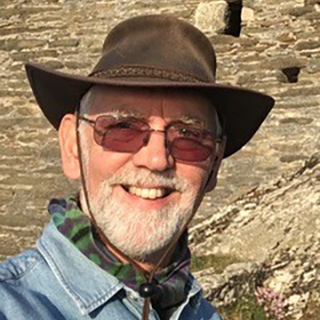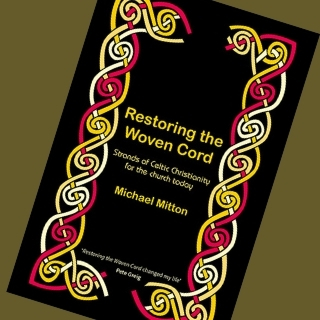To mark the beginning of Creationtide, or the Season of Creation (1 September–5 October), Michael Mitton, author of Restoring the Woven Cord and Seasoned by Seasons, has written a special reflection on the Celtic Christian understanding of the sacred nature of creation…
5 September 2021
Creation is groaning
In the last couple of years, due to the pandemic, I have had to cancel six pilgrimages that I would have co-led with my good friend Russ Parker. These would have been to Wales, Ireland, Scotland and Assisi.
I have always looked forward to these pilgrimages and it has been very sad to have had to cancel or postpone them (a minor loss, of course, compared to what some have had to suffer). Apart from the Assisi pilgrimages, all our trips are to parts of Britain and Ireland where there have been significant stories connected to the evangelisation of these islands during the Celtic era.
An outdoor spirituality
All the ancient Celtic sites we visit are out of doors. We visit windswept islands, soggy hillsides, seashore caves, bubbling wells and ancient ruins lying in open fields. In all these places we remember the stories of our spiritual ancestors who trod these lands proclaiming Christ and building communities of faith that transformed the fortunes of the people who lived here.
Thus, we may find ourselves scrambling over the rocks to Cuthbert’s Isle on Lindisfarne, where we remember the rugged Cuthbert who loved islands so much that he spent much of his ministry on one.
Or it may be clambering up the six hundred steps of the much more remote island of Skellig Michael in Ireland to the neatly built village of beehive huts near its summit, and there imagine the lives of dramatic faith that were lived out on this wild rock.
Or a visit to the coastal path near St Davids, where we draw cool and brilliantly clear water from Non’s well and remember David’s mother giving birth to him during a violent thunderstorm.
‘In all these places we remember the stories of our spiritual ancestors who trod these lands proclaiming Christ.’
These are just a few of the many sites of historical and spiritual significance that can be found in these islands. On every day of our pilgrimage we take notice of the weather forecast, but are seldom deterred by it. The weather has a different significance on a pilgrimage.
Often, we have stood in the rain at some holy place and prayed for God’s blessing on each pilgrim. Personally, I prefer not being drenched, but I have watched with great admiration how the pilgrims are undaunted, and often, despite the chill and damp, hear messages from heaven through the falling rain.
We have also had our days filled with radiant sun. After several days of cold and wet on a pilgrimage to Cornwall, the sun shone brilliantly on a Pentecost Sunday and by the ancient well of St Ruan, my dear friend Bishop Eric Pike celebrated a Eucharist for a group of South African pilgrims. On that occasion there was no doubt that the sun represented the warmth and light of God’s Holy Spirit.
In Assisi, we have known much more sunshine, and there we have walked in the footsteps of Francis and Clare, who passionately loved the land on which their remarkable ministries were so dramatically played out. Franciscan and Celtic spirituality share this great love and respect for creation, not least because the Christianity of these founders of faith was very much an outdoor faith, so there was this acute awareness of the Spirit of God quivering and electric in all aspects of creation. For them, the created order was full of possibilities. At any moment there might be a theophany.
‘There was this acute awareness of the Spirit of God quivering and electric in all aspects of creation.’
A creation that communicates
It was the custom of the early Celtic Christians to learn all the psalms by heart. In a culture where books were rare, lodging the psalms in the memory was the best way of gaining easy access to them. Psalm 19 made perfect sense to an outdoor community:
The heavens are telling the glory of God;
vv. 1-4 (NIV)
and the firmament proclaims his handiwork.
Day to day pours forth speech,
and night to night declares knowledge.
There is no speech, nor are there words;
their voice is not heard;
yet their voice goes out through all the earth,
and their words to the end of the world.
The heavens have always held fascination for the ancient mind. For the psalmist, the heavens are not just fascinating, they are communicating. They have something to say to the tiny mortals who live on planet Earth. But not only is creation speaking to us about its creator, but the creator is using his creation to speak to mortals.
Hence in Psalm 29, we read:
The voice of the Lord is over the waters;
vv. 3-4
the God of glory thunders,
the Lord thunders over mighty waters.
The voice of the Lord is powerful;
the voice of the Lord is majestic.
The prophet Isaiah tells us that creation likes praising God. ‘The trees of the field will clap their hands,’ he tells us in Isaiah 55:12. Jesus tells some grumpy Pharisees that if humans can’t praise God, then ‘the stones will cry out’ (Luke 19.40). The Bible does not recognise creation as simply an inanimate lump of matter. It communicates with mortals about the things of God and it praises its creator.
So it is not surprising that in the scriptures so many divine encounters take place in significant parts of God’s creation. Jacob meets God by the river Jabbock; Moses meets him on Mount Horeb; Elijah meets him in a cave; Jonah meets him in the belly of a whale; the shepherds meet him on the hillside; the disciples meet him walking on the turbulent lake; Paul meets him on the stormy sea; and an Ethiopian meets him in the desert. All these environments provide a context for God’s meeting with his humans.
‘The Bible does not recognise creation as simply an inanimate lump of matter.’
Sacred and defiled land
But in the Celtic mind, not all creation was seen as blessed. They knew that the sinful deeds of humankind could stain the soil. After the first murder in the scriptures, we read that the blood of Abel cried out from the ground to God (Genesis 4.10-16).
Cedd was invited to build a monastery, but Bede tells us that Cedd first had to spiritually cleanse the ground through prayer and fasting, because it had been stained by earlier crimes. For the early Celtic Christian, there was this deep interconnection between the land and the humans who dwelt on it. Land badly treated not only suffered but it could cause the humans to suffer. It could be disturbed by human blood that had been shed through violence. Many today would also testify to intuiting where places carry a sense of either being blessed or cursed.
‘For the early Celtic Christian, there was a deep interconnection between the land and the humans who dwelt on it.’
Creation, humans and the Spirit
It is significant that so many of us have returned to Celtic Christian spirituality as a resource for our discipleship today. One of the drivers for this is the crisis in our environment. Spiritualities that ignore our relationship with creation and our responsibilities towards it feel inadequate.
According to Paul, Christians, of all people, are to be sensitive to the groans of creation. In Romans 8:18-30 he provides a beautiful insight into the intricate relationship between humans, creation and the Holy Spirit, where creation itself is eagerly longing for humans to become true children of God. As children of God, we become sensitive to the groans of creation and respond with prayer and action.
‘The earth is the Lord’s’ says Psalm 24, and if that is the case then we, who are his children, must take good care of his property.
This autumn COP26 will put the environment at the forefront of our thinking for a short time. It is my growing conviction that the Holy Spirit will not want it ever to slip to the back of our minds. It has to remain a priority.

Michael Mitton works as a freelance writer, speaker and spiritual director. He is also a canon emeritus of Derby Cathedral. He has written nine non-fiction books, and more recently has taken to writing fiction through his Dorchadas Trilogy (Amazon). He lives in Derby with his wife, Julia.

Restoring the Woven Cord takes 15 leading figures from the early centuries of Christianity on the British Isles and shares something of their stories, showing their burning love for the Bible, their depth of prayer, their radical commitment to the poor and to caring for creation. Powerful inspiration for our own walk with God.
You can also receive a copy of Michael Mitton’s reflections in New Daylight by signing up to receive emails from BRF and our ministries.
BRF also publishes a range of other resources on the themes of Celtic Christian spirituality, the legacy of Francis and Clare, and the environmental emergency in which we are all caught up.
- The Celtic Year by David Cole
- Followers of the Way by Simon Reed
- Franciscan Footprints by Helen Julian CSF
- Changing the Climate by Debbie, David and Jamie Hawker
- A Christian Guide to Environmental Issues by Martin and Margot Hodson
- Green Reflections by Martin and Margot Hodson
You might also be interested in a series of beautifully produced videos which feature Michael Mitton and Restoring the Woven Cord. Entitled ‘Belong and Believe’, the films explore how our Celtic past can help us today.
The Big Church Read
The latest of our BRF authors to feature on The Big Church Read are Martin and Margot Hodson, with the fully revised and updated new edition of their A Christian Guide to Environmental Issues.
